ASSOCIATE RESEARCHER
UNIVERSITY OF CALIFORNIA
ASTRONOMY DEPARTMENT
BERKELEY CA 94720-3411
510/224-3411 (voice)
510/642-3411 (fax)
Jupiter's jet speeds in 2016.
Thurs 2016-10-20 12:22
[permalink]
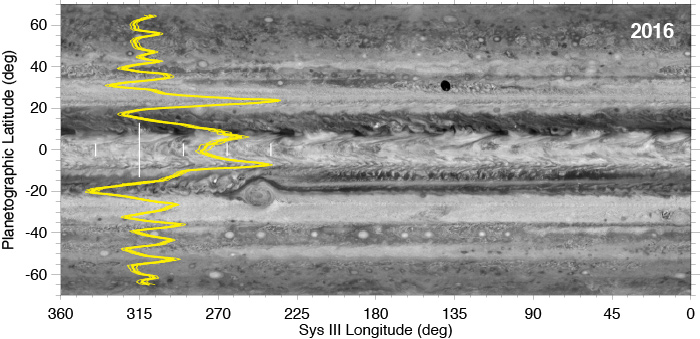
Joshua Tollefson and I have derived zonal winds from the 2016 OPAL observations of Jupiter. Josh is leading a paper on this, but we wanted to release the wind profile in advance of publication, in the hope that the profile will be useful for comparison with the Juno microwave and infrared observations coming soon, as well as the full range of earth-based support observations going on during the Juno campaign.
The OPAL maps are already available on the OPAL archive page:
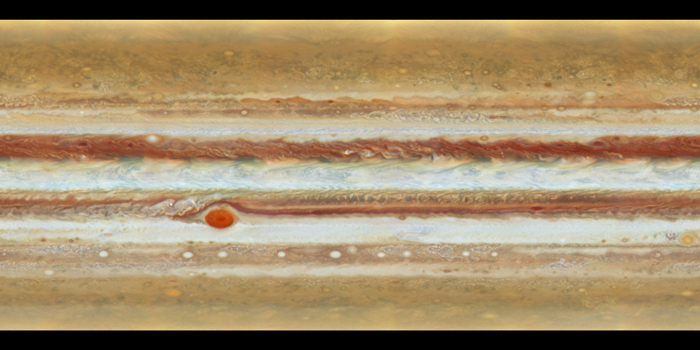
We hope to update the wind profile using new observations near December 11, when Juno conducts its next scientific measurements of Jupiter's atmosphere.
- Jupiter 2016 (April) zonal winds (141 kb text file)
- Current reference (until Tollefson et al. 2017 is published): Wong et al. (2016) DPS
- Methods used: Asay-Davis et al. (2011)
![]()
TMT protests: Balanced discussion by a biased scientist.
Wed 2015-04-21 23:59
[permalink]
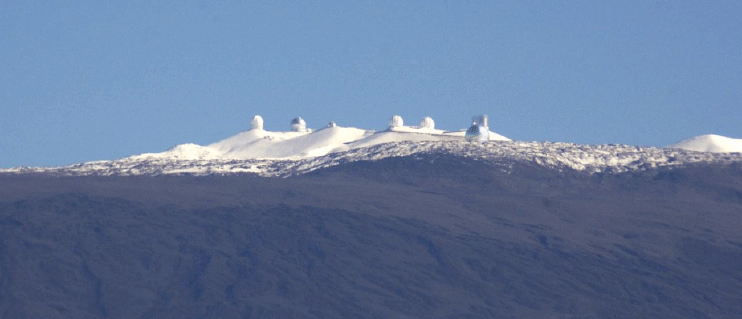
I started working with the Thirty-Meter Telescope's (TMT's) science advisory groups in 2014, eleven years after plans for the observatory started forming. At my first TMT meeting, Project Manager Gary Sanders reported on "adversarial questions" at public hearings held by TMT, and the view that observatories on Mauna Kea are like pimples on the boundary between land and sky. One thing Sanders impressed me with was his deeply respectful tone when discussing difficulties he called "more complicated than adaptive optics."
Adaptive optics is a simple battle, with a single metric of success: it's astronomers vs. atmospheric turbulence, where the winner is determined by the value of the Strehl ratio. But on Mauna Kea now, there are a host of factors to take into account. The advance of human knowledge of the universe. The undisputed best weather and clarity, darkest skies, and driest air in the northern hemisphere. The educational and economic state of a people oppressed and colonized for over 100 years. The ancestral, spiritual link to the Earth. The ability of different groups of humans to reach mutual respectful agreements. Religious freedom. Biodiversity. Fragile ecosystems. A clean line between land and sky.
Some facts and promises
Some of the objections to TMT are factually incorrect. A calmly-worded opposition statement claimed that the "Natural habitat, the watershed, conservation laws, cultural relevance, the illegal occupation of Hawai'i and a vision for the future are all being ignored as construction teams prepare to move forward." Another objection holds that lucrative Mauna Kea observatories generate millions of dollars of revenue, which are not shared with their Hawai'ian hosts. Some of these are easy to discount:
- A very rigorous environmental impact study was conducted, and the observatory is to be a zero-waste facility.
- The pimple effect is reduced by a location down from the summit and to the northwest. Only 14% of the island of Hawai'i actually has a line of sight to the observatory. The 600-ft elevation drop (compared to the higher-seated domes) reduces the area that will be able to see TMT, at a dear price to astronomers (the lowest-elevation domes are often the first to close when fog rolls in). The picture above shows that even from Waimea, where TMT would be visible, its much larger dome is less obtrusive than existing domes, due to the lower elevation of TMT.
- The TMT site will not disturb any pu'u (cinder cones of spiritual significance). This is in contrast to prior observatory construction, which flattened some pu'u, leading to increased opposition to observatories on the summit.
- TMT will directly support a vision for the future by creating jobs, many of them skilled tech jobs, for Hawai'ians. Substantial annual funding is already giving educational support to train Hawai'ians in STEM fields.
- Observatories do not "generate revenue." There are a few for-profit observatories, and selling observing time is also being contemplated to sustain aging facilities like Lick. But world-class research facilities like TMT are actually revenue suckers, draining money from governments and universities to conduct scientific research with no concrete monetary benefit whatsoever.
And the native Hawai'ian voice is diverse. Some in favor of TMT say that the ancestors would be proud of Hawai'i's role in astronomical progress, and that the TMT project contributes to island education, culture, and economy. A concise (compared to this) and eloquent petition in favor of TMT was written by 18-year old native Hawai'ian Mailani Neal.
R.E.S.P.E.C.T.
One common complaint is the lack of respect coming from astronomers. In 2006, Kealoha Pisciotta (one of the first native Hawai'ians to work as a Mauna Kea telescope technician) expressed frustration that astronomers "never once have said, 'We screwed up and we're sorry.' They never once said, 'Thank you for letting us use your sacred temple.'" And professional activist Walter Ritte said he was so disappointed with University of Hawai'i's community dialogue in response to recent protests, that his "goal now is not to stop the building of this observatory. The goal now is to get all of these observatories off this mountain. They have crossed the line and they have really angered the Hawai'ian community."
The issue of respect is highly emotionally charged. And honestly, astronomers should be held accountable for lack of respect. But on an institutional level, TMT's engagement with the native community, and its adherence to the spirit and letter of the construction approval process, speak to strong respect for Hawai'ian values. I learned much much more about Hawai'ian culture from reading TMT's own Use Permit Application than I did from following #TMTshutdown tweets.
On an individual level, planetary astronomers including Mike Brown and Imke de Pater have demonstrated great respect for Hawai'ian culture by honoring it within their work. Haumea (Pluto's cousin), and its two small moons Hi'iaka and Namaka, were given names of Hawai'ian deities, linked by intricate similarities between the Hawai'ian legends and the physical characteristics of the objects themselves. In 2002, years before Pisciotta complained of a lack of gratitude among astronomers, de Pater's acknowledgements in a journal article about the atmosphere of Jupiter's moon Io read "The authors extend special thanks to those of Hawai'ian ancestry on whose sacred mountain we are privileged to be guests. Without their generous hospitality, none of the observations presented would have been possible."
Self-determination of minority peoples
But the protests against TMT are being used to "highlight another cause: Hawai'ian sovereignty." This may not seem fair to TMT. But guess what else isn't fair? A century of colonialist domination of Hawai'i, from the overthrow of Queen Lili'uokalani to the "banning" of Hawai'ian language in schools.
The suppression of Hawai'ian culture left folks with a diminished ability to provide community input when the first telescopes were being built on Mauna Kea. Even though TMT is exercising much greater sensitivity and respect in its current process, old resentments are now being spoken in a stronger voice. The hashtag is mightier than the pen.
TMT is a partnership between US universities (including University of Hawai'i), China, India, Japan, and Canada. The world is watching this controversy. People in the USA have been quick to condemn Chinese practices ranging from the colonization and cultural suppression of Tibet, to forced displacement for large public works projects like the World Expo or the Three Gorges Dam. It is essential that we set a good example for our TMT partners by respecting Hawai'ian beliefs, protecting Hawai'ian lands, and listening to the broad range of Hawai'ian viewpoints both in favor of TMT and against it.
I would rather see the telescope built at an inferior site, rather than built without respect for native values as previous observatories were. But much has changed since observatories began popping up on Mauna Kea. No new observatories will ever be placed atop the summit or on/near sacred pu'u. TMT's construction/operations plan resulted from a process of respectful dialog, and this process also deserves respect.
![]()
Moon shadow, moon shadow.
Fri 2015-03-20 21:28
[permalink]

A lot of cool things have been going on lately with solar eclipses on Jupiter, or "shadow transits." Giovanni Cassini was the first to actually observe one of these events (upper left), back in the 1600s at the dawn of the telescopic era of astronomy. He used his observations to implement one of Galileo's ideas: to use the timing of mutual events (eclipses and transits) as a type of absolute clock that could work anywhere on the Earth, back before atomic clocks or quartz oscillators were available.
These events can be visually stunning, as the Hubble images of a rare triple-transit (lower left) show. Last month, I joined some Space Telescope Science Institute folks and Scott Lewis from knowthecosmos.com for a 1-hour chat about the spectacular Hubble imaging data (lower right). It was a good time, and Susana Deutua from the Institute showed off her Galileoscope, a replica of the telescope used by Galileo himself.
Just this week, right in the middle of the LPSC meeting, I participated in a super exciting remote-observing session at the IRTF telescope on Mauna Kea. The PI of the observing program, Gordy Bjoraker, came up with a brilliant way to use shadow transits. Our goal was to measure infrared spectra, made up of thermal emission from the deeper atmosphere. We're using the data to figure out just how deep Jupiter's water clouds lie. However, near Jupiter's equator, things get tricky — thick clouds there also reflect sunlight that is still weakly present at 5-μm wavelengths. Gordy wanted to get a spectrum of just the thermal emission, without that pesky reflected sunlight. Io to the rescue! Io's shadow conveniently blocked most of the sunlight from the clouds in a little spot (screenshot by Tilak Hewagama at upper right), allowing us to take a pure thermal spectrum within the shadow.
Analysis of these fresh data will take a while, but it's definitely worth the wait. We'll be sure to have results before the Juno spacecraft gets to Jupiter and conducts its highly complementary observations.
![]()
Giant storms on giant planets
Fri 2014-10-03 10:54
[permalink]
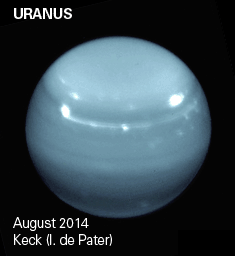
|

|
When Voyager passed by Uranus in 1986, none of this was going on. Of course, the "blue" image above is false color, applied to infrared images of Uranus from the Keck Observatory. These storms are a lot more dramatic in the infrared. But still, seven years after equinox in Uranus' 84-year annual cycle, storm activity seems to be picking up.
The storms themselves, at least visually, look similar to storms on Jupiter and Saturn, as seen in the infrared. These storms are rare on any of the giant planets, but there are a lot of questions about them. How much of the planets' internal heat do these superstorms carry? How often do they happen? Are they part of long term cycles?
This is what I love about studying the solar system. It never gets old. Things change and evolve over time.
![]()
LPSC Megablog.
Thu 2013-03-21 6:05pm in TX
[permalink]

Microblogging is really big at LPSC. I'm not a microblogger, or any kind of blogger really. I worry that as technology advances, and attention spans shrink, I am developing a mental disability. Short attention spans used to be characteristic of an attention deficit disorder. But now short attention spans are normal, and those who prefer to devote attention to things for longer amounts of time are the anomalous ones. So I think I have Attention Excess Disorder. Pharmaceutical companies, please develop some medicine for me so I can microblog.
I had lunch today with Max Mutchler from STScI (a collaborator on Planet Pipeline and Planet Investigators), and I was amazed to find out that he's a kidney donor just like me! I'm not shocked to meet a kidney donor. But to collaborate with one for more than three years, only to find this out halfway through lunch, was quite a shock. We talked about how we were affected by the situations that made our operations necessary, rather than the operations themselves.
I forgot to ask Max whether he was ever told, as I was recently by a friend, "You? You're the LAST person I would expect to be a kidney donor!"
On my quest for free stuff in the exhibitors section, I came across edible rocks courtesy of the CPSX booth (which they bought from a store nearby). Pictured are a black one and a yellow one. They look exactly like rocks, but they're chocolate! I'm looking around for Laurie Leshin, because she said during her talk that Curiosity finds 150-μm grains to be the "yummiest" dirt; but now, the rover is not the only one who eats rocks!
![]()
Using pine and bmail.
Sat 2013-02-09 18:02
[permalink]

I hate change! That's why I still use pine. My nephew saw my screen last night and was like "Wow, look at all those lines of code!" It was just pine. Nobody even knows what it is. But for the few that still use it, and who want to be able to use it with Berkeley's new bMail service, here's how to set it up.
- Follow step 1 and 2 (only) here, to set bmail configuration options and to generate a google key that you need for login: http://kb.berkeley.edu/campus-shared-services/page.php?id=26754.
- In pine, go to the setup screen (M-S-C keys). Find and set the following config lines:
SMTP Server (for sending) = smtp.gmail.com/ssl/user=username@berkeley.edu Inbox Path = {imap.gmail.com/ssl/user=username@berkeley.edu}inbox - Now when you use pine, it will prompt you for your ugly-looking google key when you try to use email. This next step is optional, but it will allow pine to retain the key so you don't have to keep entering it:
- Create your pine-password storage file, if it doesn't already exist. At the command line, type
touch ~/pine.pwd. The file name can be anything, but this is the name they used on the page that showed me how to do this. The file wil contain your google key, but encrypted. - From now on, start pine with the right option to look for the password file. You can either type the option every time, or include an alias in your startup file. I only know how to do this for the csh/tcsh shells:
cat alias 'pinemail pine -passfile ~/pine.pwd' > .cshrc. For other shells, you would probably need to change the syntax for the alias command, and/or store the command in another file (like profile.bash instead of .cshrc or something). - Now start pine, with the -passfile option. When it asks for a password, enter the google key from step 1. Pine should then store it in the pine.pwd file, so you never have to ener it again.
- Create your pine-password storage file, if it doesn't already exist. At the command line, type
Thanks Google! That was much easier than trying to get pine to work with Microsoft Exchange.
![]()
They don't make school lunch the way they used to.
Thu 2012-11-08 16:28
[permalink]
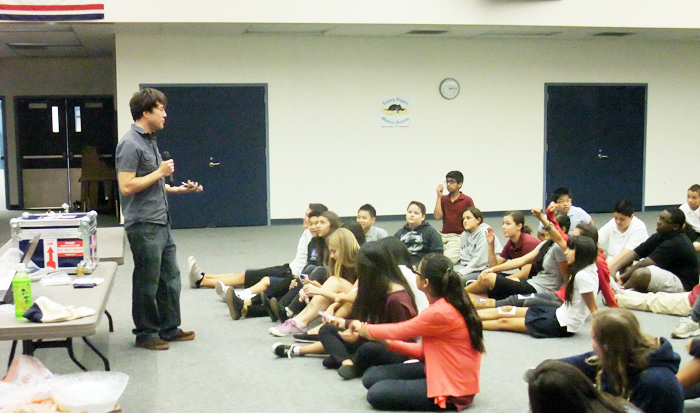
I had a great time this week, speaking to 311 students at South Pointe Middle School in Diamond Bar on Tuesday (thanks, Kellie Muragishi!), and 36 students in the Robotics Magnet Class at Audubon Middle School in Crenshaw yesterday (thanks, Eric Yu!).
JPL's Mars office set me up with a rover model and a full size model rover wheel, and Scott gave me some NASA "meatball" stickers to hand out. These were great bribes to encourage the students to ask questions at the end. Some highlights:
- I got more questions about my inspiration and enjoyment of work, than about how much money I make. But they still did ask.
- When I asked what social/environmental issue relates to CO2 in the atmosphere, none of the students in Diamond Bar guessed that I was thinking climate change. Several of the Crenshaw students almost immediately knew what I was fishing for.
- School lunches have changed since I was little... similar to how airplane food changed. They used to be little cooked meals from the school kitchen, but now the lunches are pre-packaged corporate food. I had Subway sandwich at South Pointe, and another option was a pita-pack encased in a black plastic tub with a plastic sheet that you have to peel back to get to the food. Maybe I didn't get in the right line, because another guy in the Faculty Lounge was eating a school lunch in a small white Chinese takeout box.
![]()
Flash news.
Tue 2012-09-11 12:34
[permalink]
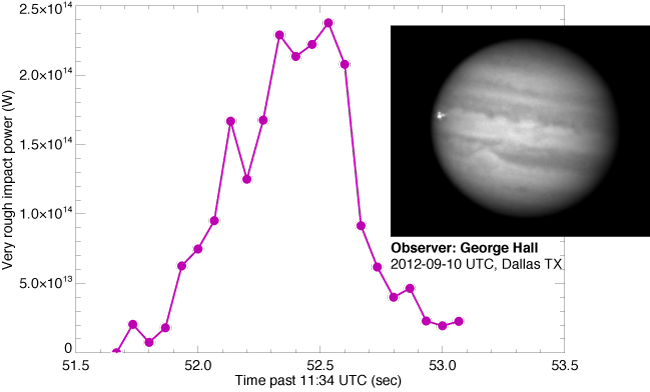
What an exciting night. Or day. Or sol?
I slept in yesterday, missing some key emails, and showed up to work "early" for my shift doing MSL operations work (at 8pm). That's when I found out there was another Jupiter fireball. This one was discovered by Dan Petersen in Wisconsin by visual observation, and confirmed when George Hall went back and found the flash in his archived video.
Being simultaneously pulled to work on Mars and Jupiter made me almost believe in astrology. I definitely felt that the planets were controlling my life.
About the image: My lightcurve has a large uncertainty, but is sufficient to predict that this event is too small to create a visible impact scar. George Hall was kind enough to share his video data for this analysis. The inset image consists of 22 frames of George's data, stacked by Ricardo Hueso and treated with a mild high-pass filter. Light curve data points are based on radial brightness curves, extrapolated to compensated for saturated pixels in the original data.
More detailed reports include:
![]()
Time Lapse Saturn/Jupiter Video: "Outer Space."
Wed 2012-05-02 12:09
[permalink]
I just found out about this awesome video by Sander van den Berg, using Voyager and Cassini imaging data. If you're like me, you've seen some of the videos in this compilation, but this is a really breathtaking new way to absorb them. A lot of physics, some understood and some not, is captured in this 1:52 piece.
![]()
Space Senator.
Thu 2012-04-12 14:01
[permalink]

I just went to browse MAST, formerly the Multimission Archive at STScI, and found out that it's been renamed. It's still MAST, but now it stands for the Mikulski Archive for Space Telescopes.
Senator Barbara Mikulski was honored for becoming the longest-serving woman in U.S. Congressional history, and also for being a great defender of space exploration and research. There are nice writeups about MAST and Sen. Mikulski on the about MAST page and a Hubble press release. Although some NASA advocates focus their support on the manned space program with its associated defense contractor expenditures, Senator Mikulski's record shows support for the kind of stuff I do: science. I'm proud that they renamed the archive after her.
![]()
Space Ronin.
Tue 2012-02-28 12:20
[permalink]
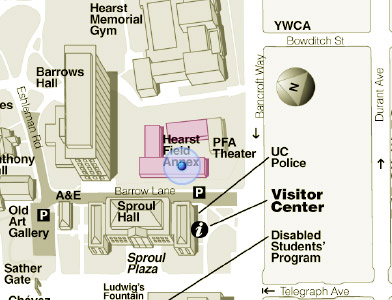
|
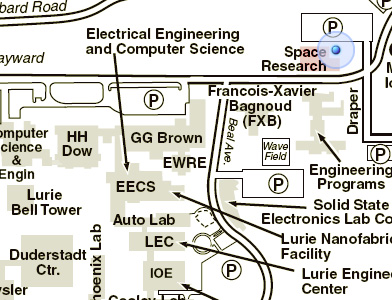
|
My career is not not going quite the way I thought it would, back when I was 18. Shouldn't I have a faculty job by now? Or a civil servant position at NASA?
These days, many people adopt different paths. We branch out, or we work at scientist farms, where top-quality researchers can sustain themselves on grants. So I'm starting a new (part-time) Visiting Scientist gig at University of Michigan, following on an awesome Visiting Scientist stint at Space Telescope in 2009-2010. At Michigan I'll be working with the SAM instrument on the Curiosity rover.
Although a part-time visiting scientist arrangement is odd, and inconvenient... I don't think it's extremely unusual these days. I'm a Space Ronin; I have no tenure and I work here and there. I'm well regarded internationally in my field, but just without the job to match. I console myself in the quote usually found on the whiteboard behind the bar at Tommy's: "IF YOU LIVE IN S.F. PLEASE REMEMBER HOW LUCKY YOU ARE."
![]()